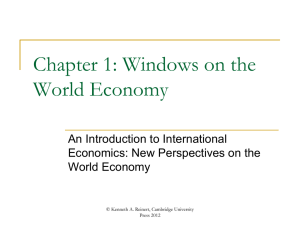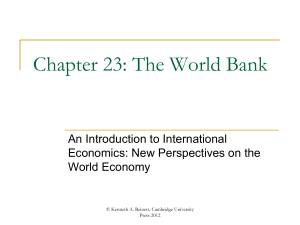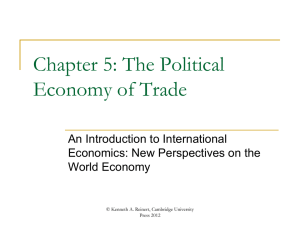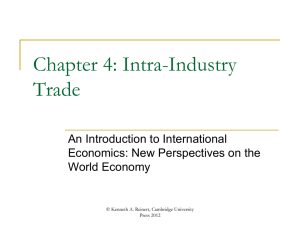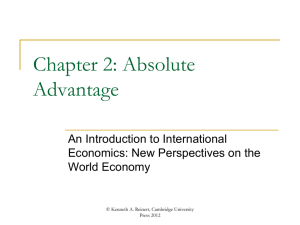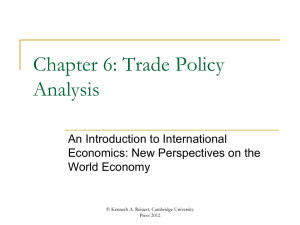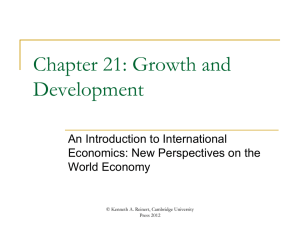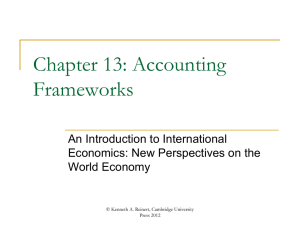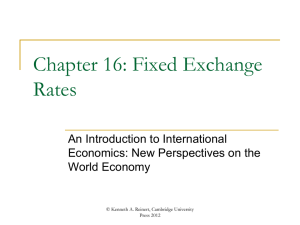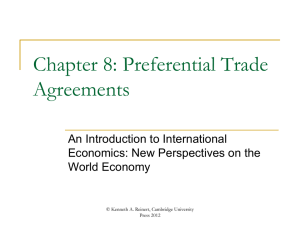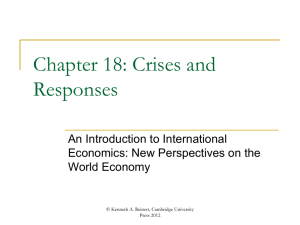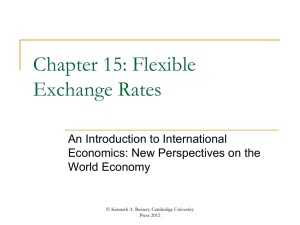Chapter 24. Structural Change and Adjustment.
advertisement
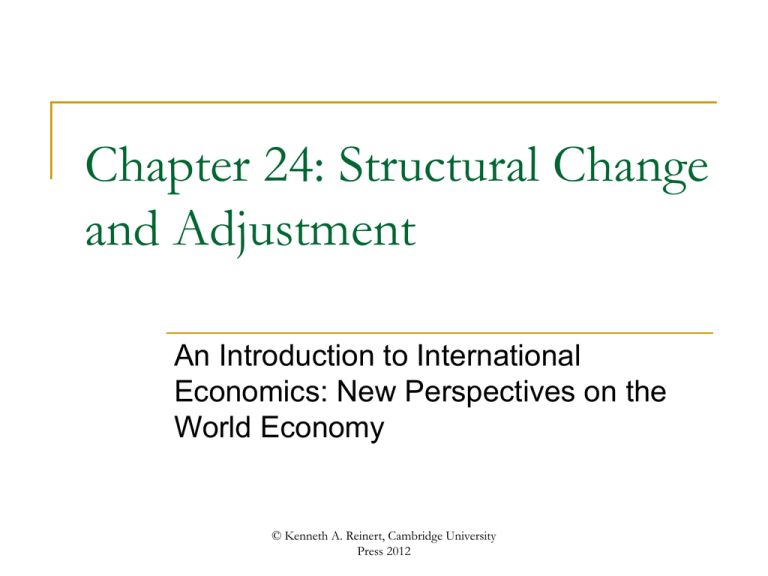
Chapter 24: Structural Change and Adjustment An Introduction to International Economics: New Perspectives on the World Economy © Kenneth A. Reinert, Cambridge University Press 2012 Analytical Elements Countries Sectors Factors Currencies © Kenneth A. Reinert, Cambridge University Press 2012 Structural Change The basic notion of structural change is that, as development proceeds, productive factors move out of lower-productivity activities into higher-productivity activities One limited application of this lens is to simply view development as the process of resources moving out of agriculture and into manufacturing This limited application ignores the important role of the service sector As development proceeds, the service sector expands, partly due to the role of producer services Evidence on this process is presented in Table 24.1 © Kenneth A. Reinert, Cambridge University Press 2012 Table 24.1: Sector Composition of GDP, Selected Years (percent of GDP) Income Sector 1970 1980 1990 Low income Agriculture 38 38 35 25 Low income Manufacturing 12 12 11 13 Low income Services 50 50 54 62 Middle income Agriculture 25 20 18 11 10 Middle income Manufacturing 24 26 23 22 20 Middle income Services 51 54 59 67 70 High income Agriculture 6 4 3 2 1 High income Manufacturing 24 21 18 16 High income Services 72 76 80 83 Source: World Bank, World Development Indicators © Kenneth A. Reinert, Cambridge University Press 2012 2000 2010 Structural Change The data presented in Table 24.1 presents gross domestic product (GDP) of low, middle and high income countries, spit up between agriculture, manufacturing and services for available years If we were to generalize from the data in this table, we can see that, as development proceeds Agriculture declines from approximately 40 percent of GDP to approximately 2 percent of GDP Manufacturing initially increases from approximately 10 percent of GDP to approximately 25 percent of GDP and subsequently falls below 20 percent of GDP Services increase from approximately 50 percent of GDP to approximately 80 percent of GDP © Kenneth A. Reinert, Cambridge University Press 2012 Structural Change: The Decline of Agriculture One reason why agriculture declines as a percent of GDP is that of what is known as Engel’s Law Engel’s law states that the income elasticity of demand for food is less than one A second reason why agriculture declines with economic growth is that it tends to be less capital intensive than manufacturing and, as economies become more capital abundant in growth processes, labor intensive sectors of the economy tend to shrink relative to capital intensive sectors (the Rybczynski theorem discussed below Finally, there is a tendency for the income elasticity of demand for services to be greater than one © Kenneth A. Reinert, Cambridge University Press 2012 Traded and Non-Traded Goods There is a particular treatment of the structure of economies that involves a distinction between traded and non-traded goods The distinction between these two categories of goods is made in Table 24.2 Non-traded goods include more service sub-sectors than traded goods, and traded goods include more agriculture and manufacturing sub-sectors than non-traded goods Some researchers go so far as to equate non-traded goods with the service sector, but this is not entirely accurate © Kenneth A. Reinert, Cambridge University Press 2012 Table 24.2: Trade Goods vs. Non-Traded Goods Good Price Determination Traded Prices of traded goods are determined in world markets. Non-traded Prices on non-traded goods are determined in domestic markets. Consumption and Production Domestic consumption and domestic production of traded goods can differ, causing a trade surplus or deficit. Domestic consumption and domestic production must be equal. © Kenneth A. Reinert, Cambridge University Press 2012 Traded vs. Non-Trade Goods in a PPF We can represent the supply side of the traded/nontraded economy with a production possibilities frontier (PPF) as in Figure 24.1 The production of traded goods as an aggregate entity is measured along the vertical axis, and the production of non-traded goods as an aggregate entity is measured along the horizontal axis The PPF depicts the combinations of output of traded goods and non-traded goods that the economy can produce given its available resources and technology The PPF is depicted as the concave line in the figure © Kenneth A. Reinert, Cambridge University Press 2012 Figure 24.1: Ghana’s PPF with Traded and Nontraded Goods © Kenneth A. Reinert, Cambridge University Press 2012 Internal and External Balance The concepts of internal balance and external balance can be considered in Figure 24.2 Ghana’s production point is given by point B Since the production point B is on the PPF rather than inside it, all of Ghana’s resources are efficiently employed This is what we mean by internal balance Ghana’s consumption point is given by point C and is exactly the same point as point B. A dotted line proceeds to the left from points B and C to the vertical axis This tells us that the consumption of tradable goods (point C) is exactly the same as the production of tradable goods (point B) This means that there is external balance © Kenneth A. Reinert, Cambridge University Press 2012 Figure 24.2: Internal and External Balance © Kenneth A. Reinert, Cambridge University Press 2012 External Imbalances Next consider Figure 24.3 This figure shows two consumption points, CTS and CTD If consumption is at CTD, the consumption of traded goods exceeds the production of traded goods along the vertical axis and Ghana has a trade deficit If consumption is at CTS, the production of trade goods exceed the consumption of traded goods and Ghana has a trade surplus In contrast to Figure 24.2, in both the trade deficit and trade surplus cases depicted in Figure 24.3, there is external imbalance © Kenneth A. Reinert, Cambridge University Press 2012 Figure 24.3: External Balance © Kenneth A. Reinert, Cambridge University Press 2012 Balance of Payments Adjustment To understand some issues behind balance of payments adjustment, we are going to consider an initial position of a trade (current account) deficit as in Figure 24.4 Included in this figure are price ratio lines We use PT to denote the price of traded goods and PN to denote the price of non-traded goods A price ratio lines in the figure indicate that consumers and firms face the price ratio PN / PT, the relative price of non-traded goods We are going to see how Ghana can adjust if this current account deficit becomes unsustainable © Kenneth A. Reinert, Cambridge University Press 2012 Figure 24.4: A Current Account Deficit © Kenneth A. Reinert, Cambridge University Press 2012 Adjustment Via Demand Reduction One possible adjustment path recognizes that the external imbalance problem comes from the demand for tradable goods being too high Therefore demand reduction is required to reduce the demand for tradable goods as in Figure 24.5 We begin with consumption at CTD1 and production at B1 If we reduce incomes to the value of production at point B1 , consumption would fall to CTD2 At CTD2, there is still a current account deficit of TD2 We can maintain employment in the traded goods sector and moving production and consumption to points B3, C3 External balance has been achieved at the cost of internal balance © Kenneth A. Reinert, Cambridge University Press 2012 Figure 24.5: Adjustment Bia Demand Reduction © Kenneth A. Reinert, Cambridge University Press 2012 Adjustment Via Demand Switching An alternative adjustment path involves demand switching through a change in the nominal exchange rate (devaluation or depreciation) If the currency were to lose value, the price of traded goods would increase, and the PN / PT line would flatten As can be seen in Figure 24.6, this has two effects First, it increases the incentive to produce traded goods Second, it decreases the incentive to consume traded goods Both of these effects tend to reduce the trade deficit Adjustment can proceed without necessarily increasing unemployment © Kenneth A. Reinert, Cambridge University Press 2012 Figure 24.6: Adjustment via Demand Reduction and Switching © Kenneth A. Reinert, Cambridge University Press 2012 Traded Goods and Growth Some researchers have attempt to establish a relationship between the production of tradable good in developing countries and growth We can visualize this argument in Figure 24.7 The increased production of traded goods involved in the movement from point B1 to point B2 causes positive growth externalities This has the effect of shifting out the PPF along the traded goods axis The economy ends of at point B3, C3 on an expanded PPF © Kenneth A. Reinert, Cambridge University Press 2012 Figure 24.7: Adjustment via Demand Reduction and Switching Reconsidered © Kenneth A. Reinert, Cambridge University Press 2012 The Order of Economic Liberalization Traditionally, structural adjustment programs have included the following components Exchange rate depreciation or devaluation Reductions in government expenditures, including reduction in public sector workforces, elimination of agricultural and industrial subsidies, and elimination of food and medical subsidies Wage controls to reduce demand and to prevent inflation Elimination of import quotas and export taxes Reduction of ad valorem tariffs to “moderate” levels of 10-15 percent The privatization of state-owned enterprises The liberalization of domestic financial markets © Kenneth A. Reinert, Cambridge University Press 2012 The Order of Economic Liberalization There is evidence that failure to consider the order of economic liberalization can significantly compromise the sustainability of adjustment policies Here is one possible order of economic liberalization Seek a means of securing central government revenue through a broad-based tax Depreciate or devalue the exchange rate to initiate switching Tariffy quotas on imports of consumer goods and remove quotas on imports of intermediate and capital goods Selectively begin to privatize state owned enterprises Liberalize the foreign direct investment component of the capital/financial account Develop an effective system of bank regulation © Kenneth A. Reinert, Cambridge University Press 2012 The Rybczynski Theorem The application of the Rybczysnki theorem for our purposes here is due to an increase in physical capital relative to labor in a process of capital deepening discussed in Chapter 21 This is presented in Figure 24.8 An increase in physical capital favors the capitalintensive sector (motorcycles) over the labor intensive sector (rice) The PPF consequently moves out more along the M axis than along the R axis © Kenneth A. Reinert, Cambridge University Press 2012 Figure 24.8: The Rybczynski Theorem © Kenneth A. Reinert, Cambridge University Press 2012 The Rybczynski Theorem For a given world price ratio, the production point moves from B1 on the original PPF to B2 on the new PPF As we can see in the figure, this involves an increase in the production of motorcycles but a decrease in production of rice The increase in physical capital via capital deepening results in a shift of the structure of the economy away from rice (the labor-intensive sector) and towards motorcycles (the capital-intensive sector) This is an insight that comes from the Rybczynski theorem and reflects what happens as countries accumulate physical capital © Kenneth A. Reinert, Cambridge University Press 2012
